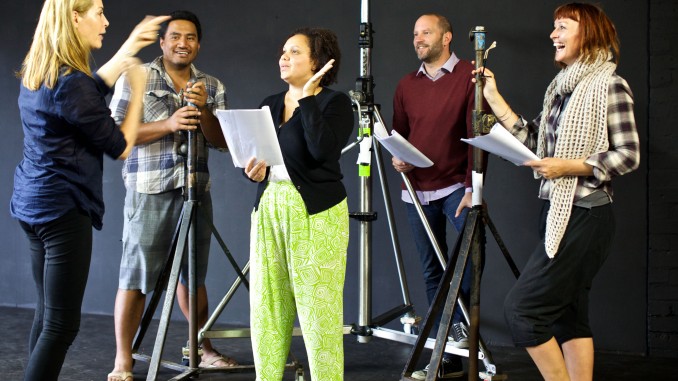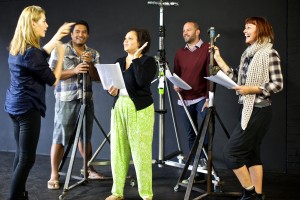
Deserves a more thorough investigation [by Matt Baker]

On the international stage New Zealand is a young country with a comparatively less violent history than the birth lands of its colonial forefathers, but violence is violence, and even the smallest act can reverberate across the globe. The death of Fernando Pereira, son, husband, father, may not have directly affected the lives of those outside his Dunbar number, but the cause of it was an unquestionable blow to the nation. The sinking of the Rainbow Warrior has been explored in books, film, and television, but not to the extent one would expect such a significant source of drama to be.
Enter The Large Group and Last Tapes Theatre Company in a joint venture to produce playwright Bronwyn Elsmore’s Fallout, six years after it was written and 30 years since the event that inspired it. It begins with a beautiful and provocative monologue by Kerry Warkia, accompanied by hypnotic projections by Jeremy Fern that continue throughout to give literal background to the play, before launching into the infamous incident and the people caught in its wake. Luanne Gordon and Toby Leach are immediate drivers of the narrative, Elsmore’s words projecting from within them with the utmost conviction and truth as they recall the circumstances leading up to the attack.
A significant shift then occurs in the narrative as both an investigation and the story takes to the road. At this point, Fasitua Amosa’s comedic abilities warm him into the show, as the cast present multiple characters who aid the police in their search for our countries most sought after foreign criminals. However, when perspectives are focused on the primary conditions of who, what, when, where, and how, we have little more than facts with which to engage, and while the cast, under the direction of Jennifer Ward-Lealand, do an excellent job of sustaining the pace of the play, the lack of shifts results in a monotonously chronological watch.
The script verges on verbatim theatre, but seems to ironically lack the poignancy that everyday speech can contain when presented in an artistic medium. Asides from two particular moments by Amosa and Gordon respectively, there is little resonance in the text other than the opening monologue. Fortunately, Paul McLaney’s music and sound design is an immediate cue into the play and provides the emotional content lacking in the script. Unfortunately, to allow the full effect of Fern’s visual design, lighting designer Sean Lynch is very limited, and the darkness of the theatre is slightly sleep inducing in combination with the heat of a full audience.
There’s no argument against the worth of this production. Those that remember the sinking of the Rainbow Warrior will no doubt have an emotional response to the reminiscence of the narrative, and for those who have no primary memory of the event, it’s the history lesson we never got in school. LTTC and TLG are also clearly invested in not only putting on a show, but ensuring that it is seen. In conjunction with The Basement’s Schools Programme and New Zealand Sign Language, those communities and others are provided an opportunity not often extended to them. As a play, however, Fallout has not brought anything new to the artistic conversation of one of our country’s most patriotic periods.
Fallout is presented by The Large Group and Last Tapes Theatre Company and plays at The Basement until May 30. For details see The Basement.
SEE ALSO: Theatreview.org.nz review by Kathryn van Beek and Metro Magazine review by James Wenley

Leave a Reply